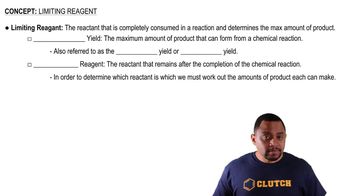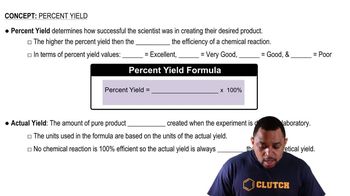Magnesium oxide can be made by heating magnesium metal in the presence of oxygen. The balanced equation for the reaction is: 2 Mg(s) + O2(g) → 2 MgO(s) When 10.1 g of Mg reacts with 10.5 g O2, 11.9 g MgO is collected. Determine the limiting reactant, theoretical yield, and percent yield for the reaction.
Many computer chips are manufactured from silicon, which occurs in nature as SiO2. When SiO2 is heated to melting, it reacts with solid carbon to form liquid silicon and carbon monoxide gas. In an industrial preparation of silicon, 155.8 kg of SiO2 reacts with 78.3 kg of carbon to produce 66.1 kg of silicon. Determine the limiting reactant and the theoretical yield.
 Verified step by step guidance
Verified step by step guidanceKey Concepts
Limiting Reactant

Theoretical Yield

Stoichiometry

Urea (CH4N2O) is a common fertilizer that is synthesized by the reaction of ammonia (NH3) with carbon dioxide: 2 NH3(aq) + CO2(aq) → CH4N2O(aq) + H2O(l) In an industrial synthesis of urea, a chemist combines 136.4 kg of ammonia with 211.4 kg of carbon dioxide and obtains 168.4 kg of urea. Determine the limiting reactant, theoretical yield of urea, and percent yield for the reaction.
Many computer chips are manufactured from silicon, which occurs in nature as SiO2. When SiO2 is heated to melting, it reacts with solid carbon to form liquid silicon and carbon monoxide gas. In an industrial preparation of silicon, 155.8 kg of SiO2 reacts with 78.3 kg of carbon to produce 66.1 kg of silicon. Determine the percent yield for the reaction.
Calculate the molarity of each solution.
a. 3.25 mol of LiCl in 2.78 L solution
b. 28.33 g C6H12O6 in 1.28 L of solution
Calculate the molarity of each solution.
c. 32.4 mg NaCl in 122.4 mL of solution
